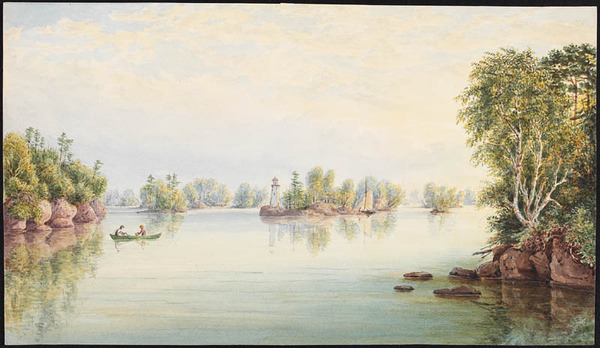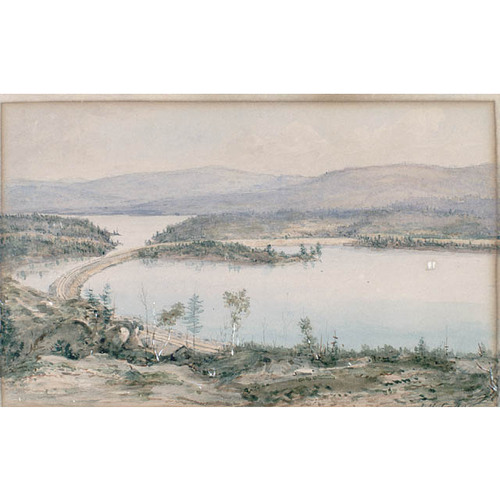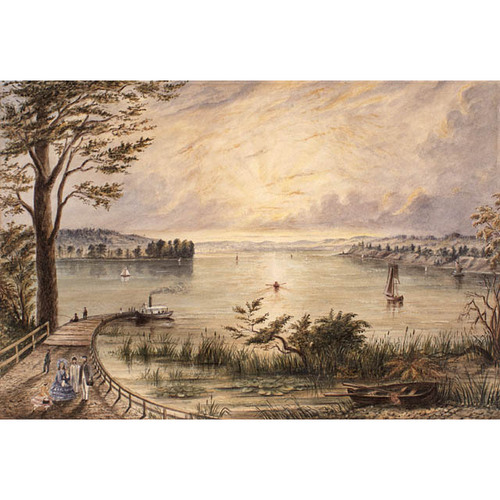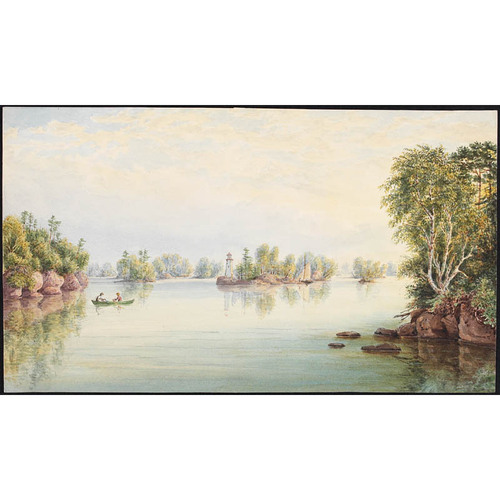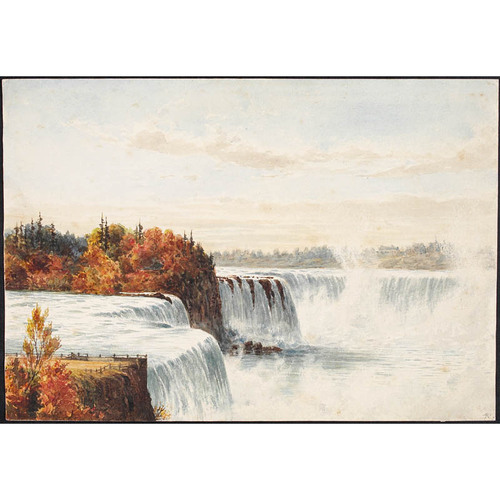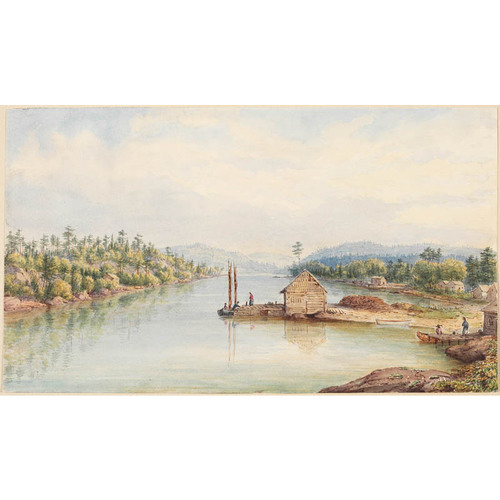CADDY, JOHN HERBERT, soldier, engineer, teacher, and artist; b. 28 June 1801, in Quebec City, Lower Canada, son of Colonel John Thomas Caddy of the Royal Artillery and Hannah Godard (Goddard); d. 19 March 1883 at Hamilton, Ont.
John Herbert Caddy was born into a family of military engineers. His grandfather had been sent to Newfoundland in the 18th century to build a fort. In about 1796 his father left Kent, England, for a posting in Lower Canada and in 1808 was transferred to the garrison at Fort Malden, Amherstburg, Upper Canada. John Herbert began his schooling at Amherstburg and in 1815 he was sent to England for military training at the Royal Military Academy, Woolwich (now part of London). In March 1816 he was enlisted at the academy as a gentleman cadet in the Royal Artillery and received training as an engineer and cannoneer. Like George Heriot*, James Pattison Cockburn*, Philip John Bainbrigge, and other English military artists who painted Canadian scenes, Caddy was trained at Woolwich in topographical sketching and painting. Much of his free time was spent at the home of a family friend, Colonel Richard Hamilton, at Woolwich Common. Caddy was commissioned 2nd lieutenant on 29 July 1825 and promoted 1st lieutenant in 1827. In 1828 he married Colonel Hamilton’s daughter Georgiana, shortly before he left for duty in Tobago.
He returned to England in 1831, but after two years left his family for his second West Indian posting, at St Lucia. In May 1834 he was transferred to St Vincent where he was joined later by his wife and family. Diary fragments describe the social rounds, the hunting, and the sketching which were possible with light military duties. Before he left for St Vincent Caddy had prepared for publication a series of four folios of scenes, largely of the West Indies. The pictures of the first folio were engraved in London and were published in 1837 by Ackermann; the other three folios never appeared.
Caddy returned with his family to Woolwich in July 1837. After a year of relaxation he was posted to British Honduras (Belize) in December 1838 where he served as harbour-master at the town of Belize, the capital. In November 1839 he and Patrick Walker, secretary to the settlement’s superintendent, led a hastily organized official expedition to the ruins of the Mayan city of Palenque, not far inland from Belize. On his return Caddy prepared from his diary and sketches a text and illustrations for their official report to Westminster which he intended to publish as a book, but John Lloyd Stephens and Frederick Catherwood, leaders of a rival American expedition to Palenque, managed to get out a popular account first. Caddy’s Palenque diary, text, and illustrations, along with fragments of earlier diaries, were finally collected and published in 1967 by David Michael Pendergast.
Caddy returned to Woolwich in 1841 as a captain. He was appointed to Malta the next year, but exchanged that posting for one to London, Canada West. Two years later he was assigned another West Indian tour of duty, but, deciding to remain in London, he retired on half pay. His family of eight children was to include three born in Canada. As civil engineer for London, Caddy laid out plans for the growing community, and he acquired considerable land in the centre of the town. He also began to paint Canadian landscapes.
In 1851 Captain Caddy disposed of his land in London and moved to Hamilton where he lived for the next 32 years until his death. After a brief employment as a civil engineer on the Great Western Rail Road, he had turned to painting as his profession. He opened a studio, gave private lessons, and served as art instructor at Wesleyan Female College (later renamed Hamilton Ladies’ College).
Caddy was a painstaking artist who worked slowly and carefully from pencil sketches made on the scene, through sepia drafts, to the finished picture. Apparently he sometimes completed several versions of the finished landscape but rarely, if ever, signed his work. He exhibited water-colours and oils in the annual provincial exhibitions from 1858 to 1868, winning awards for his meticulous landscapes, marines, and animal and flower studies. In London he had painted a portrait of Colonel Thomas Talbot*, but his strength was not in portraiture or in the figure. While in Canada he copied some scenes of Great Britain, Ireland, and the West Indies he had painted earlier. He did landscapes of scenes in and around Hamilton, Toronto, Brantford, Queenston, Niagara, and London, as well as farther afield, in the regions of Lake Huron, Georgian Bay, Muskoka, Lake Superior, the St Lawrence River, and New Brunswick. He also painted scenes of the Kawartha Lakes; his father and two younger brothers had taken up land in Douro Township in 1834 and were neighbours of the Stricklands, Traills, and Moodies. Caddy visited his family in Douro in 1841 where he likely met Samuel Strickland* but by that time the Traills and Moodies had moved. Other members of Caddy’s family, including his brothers Edward C. and Douglas T. as well as one of his own sons, were also amateur or professional artists.
The most complete list of the institutions holding works by J. H. Caddy appears in Harper, Early painters and engravers. Other works are held in private collections, in Dundurn Museum (Hamilton, Ont.), and by the Warnock-Hersey Company (Montreal). A typed draft of a dictation by H. G. Caddy and family letters are in the possession of Helen Caddy Roper (Peterborough, Ont.). For his expedition to Palenque see: Palenque: the Walker-Caddy expedition to the ancient Maya city, 1839–1840, ed. D. M. Pendergast (Norman, Okla., 1967).
Canadian Illustrated News (Hamilton), 24 Oct. 1863. Hamilton Spectator, 21 June 1883. Mary Allodi, Canadian watercolours and drawings in the Royal Ontario Museum (2v., Toronto, 1974). Landmarks of Canada: what art has done for Canadian history . . . (2v., Toronto, 1917–21; repr. in 1v., 1967). Painters in a new land: from Annapolis Royal to the Klondike, ed. Michael Bell (Toronto, 1973). Mabel Burkholder, “Retired artillery officer becomes local artist,” Hamilton Spectator, 15 April 1952. “Hamilton in the fifties,” Hamilton Spectator, 14 Feb. 1942.
Cite This Article
Gordon Roper, “CADDY, JOHN HERBERT,” in Dictionary of Canadian Biography, vol. 11, University of Toronto/Université Laval, 2003–, accessed December 18, 2025, https://www.biographi.ca/en/bio/caddy_john_herbert_11E.html.
The citation above shows the format for footnotes and endnotes according to the Chicago manual of style (16th edition). Information to be used in other citation formats:
| Permalink: | https://www.biographi.ca/en/bio/caddy_john_herbert_11E.html |
| Author of Article: | Gordon Roper |
| Title of Article: | CADDY, JOHN HERBERT |
| Publication Name: | Dictionary of Canadian Biography, vol. 11 |
| Publisher: | University of Toronto/Université Laval |
| Year of publication: | 1982 |
| Year of revision: | 1982 |
| Access Date: | December 18, 2025 |


